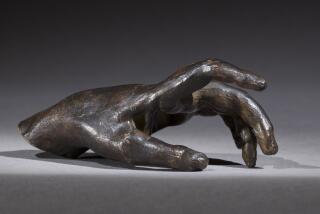19th Century Sculpture by H. W. Janson (Abrams: $45; 288 pp., illustrated)
The 19th Century was one of the greatest centuries for sculpture. Statues popped up everywhere in the cities of the West: in parks and squares, on street corners, on facades, in churches, and in the foyers of government buildings, and much of it was paid for by public subscription. Museums too filled up with marbles of heroes and nudes; and middle-class parlors were sprinkled with small bronzes and plasters of more nudes, heroes and animals.
The statue mania ended just before the World War I. Thereafter, the statues on the streets were ignored or moved when no one cared (do you remember the sculpture on San Francisco’s Market Street before BART?); the museum marbles were put in storage; the living room bronzes were banished to the attic. A great period of sculpture was forgotten, almost lost.
Things should change now with the publication of H. W. Janson’s posthumous “19th Century Sculpture,” the first serious international survey of the field. It is not a scholarly work, not even a reference book; it is, nonetheless, a superbly written introduction to artists and works that will interest the general public as well as the art historian. The only competition, “19th Century Sculpture” by Maurice Rheims (Abrams, 1975), was not a serious survey, despite its 685 illustrations. The text--unmotivated by curiosity or enthusiasm, and unsupported by research or observation--was dull and uninstructive. Not this book. The commanding intelligence that has kept Janson’s “History of Art” beating the competition in college survey courses since 1962 is still in control here. And Janson’s prose is so clear, so graceful, agile and beguiling that readers will forget that they are reading art history.
The book is divided into four large chapters that match periods of European history as much as they do movements in art. Within each chapter the lives and works of more than 100 sculptors are discussed, country by country, from Western Europe and North America. Janson uses his 320 beautiful illustrations well. Almost half of them are from photos he took himself, which shows the personal quality of his research.
Janson does not dispute the common opinion that the super star of the century is Rodin,and gives him more space and more illustration than he does to any other master; yet these passages are as fresh as those about the sculptors whom he himself discovered. For the first time we have, in this book, Rodin considered in the context of contemporary sculpture instead of as an isolated genius.
The other stars of the book are not too surprising. Those already somewhat experienced in the area will be glad to see and read more about Canova, Carpeaux, Houdon, Dalou, Rude, David d’Angers and Falguiere. Other than these names, very few others will be familiar. Some readers will be disconcerted by the praise for the Victorian sculptor Alfred Gilbert. On the other hand, they should be pleased that Auguste Bartholdi is finally given an artistic identity beyond that of being the sculptor of the “Statue of Liberty.”
Three Americans--the eccentric but inventive William Rimmer, the inevitable Saint-Gaudens, and the chaste Hiram Powers, sculptor of the ever popular “The Greek Slave”--are given lengthy consideration.
Hiram Powers was a Swedenborgian who believed that the body was “the garment of the soul.” In a limpid passage of surprising compactness, Janson not only interprets the religious symbolism of Powers’ nude figures, but also works in a description of his technical innovations. It is Janson’s grasp of the intellectual, aesthetic and technical goals of individual sculptors--a grasp that is based on both intuition and scholarship--that enables him to understand forgotten works, and his prose passes the excitement of his comprehension on to the reader.
Janson’s “19th Century Sculpture” seems to have been written especially for Angelenos. Our interest was already awakened in 1981 by the excellent exhibition “From the Romantics to Rodin, French 19th-Century Sculpture” at the County Museum of Art. Janson was one of the organizers, along with Peter Fusco, of that famous show. And Fusco, while curator of sculpture at the County Museum, built up a large and splendid international collection of 19th-Century sculpture of the highest quality--bronzes, marbles, plasters, terra-cottas in all sizes--another treat for readers of this book who can test out immediately what they have learned.
More to Read
The biggest entertainment stories
Get our big stories about Hollywood, film, television, music, arts, culture and more right in your inbox as soon as they publish.
You may occasionally receive promotional content from the Los Angeles Times.










